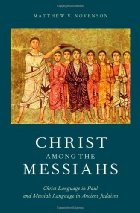What “Messiah” meant at the time of Paul and the earliest Christians
Continuing with notes from Christ among the Messiahs: Christ Language in Paul and Messiah Language in Ancient Judaism
by Matthew V. Novenson
.
 The messianic idea
The messianic idea
We saw in Part 1 that interpreters of Paul have confidently concluded that whatever Paul meant by χριστός he did not mean “messiah”, but modern studies of messianism have shown that the meaning of “messiah” remains an open question.
Understanding what was meant by “messiah” was much simpler throughout the nineteenth and early twentieth centuries. Jewish and Christian scholars alike took for granted the existence of “the messianic idea” that was widely understood throughout the period of ancient Judaism. The evidence for this idea was not found in every text that made mention of a messiah, but it could be cobbled together by combining motifs from different documents.
So the Christian scholar, Emil Schürer, on the basis of the Apocalypse of Baruch and the fourth Book of Esdras, showed that this messianic idea entailed the following:
- The final ordeal and confusion
- Elijah as precursor
- The coming of the messiah
- The last assault of the hostile powers
- Destruction of hostile powers
- The renewal of Jerusalem
- The gathering of the dispersed
- The kingdom of glory in the holy land
- The renewal of the world
- A general resurrection
- The last judgment, eternal bliss and damnation
Jewish scholarship did not substantially differ, as seen from Joseph Klausner’s list of ingredients that make up the messianic idea:
- The signs of the Messiah
- The birth pangs of the Messiah
- The coming of Elijah
- The trumpet of Messiah
- The ingathering of the exiles
- The reception of proselytes
- The war with Gog and Magog
- The Day of the Messiah
- The renovation of the World to Come
Klausner conceded that no single text sets out this complex of ideas in full, but these points nonetheless are what the disparate texts mean when put together.
In other words, if a literary text lacks some of the pieces, that is the fault of the text, not of the messianic idea. The idea exists prior to and independently of the texts. (p. 37)
The messianic idea psychologized
What is more, in most modern accounts the messianic idea is described in specifically psychological terms: It is the force that animates the pious Jewish hope for redemption, either throughout Jewish history (in Jewish treatments) or at the time of Christ (in Christian treatments).
In this train we find discussions of the messianic idea arising out of a tenacious belief in a better future despite overwhelming troubles facing the present. Some authors have seen this as one of Judaism’s special gifts to the world alongside monotheism and ethical codes. Scholarly study has accordingly been less about the messiah figure than about the religious attitude and ideology that was the backdrop to various beliefs in such a figure.
The messianological vacuum
The concept of the “messianic idea” in Judaism started to unravel at the end of the Second World War with the discovery of the Dead Sea Scrolls. Scholars increasingly argued that the words for “messiah” and “christ” in the Second Temple period “had no fixed content” (De Jonge) and may even have had no special significance or meaning at all (James Charlesworth, Jacob Neusner, William Scott Green). They were labels that could be, and were, applied to a wide variety of persons and things. Continue reading “Christ among the Messiahs — Part 2”
Like this:
Like Loading...








